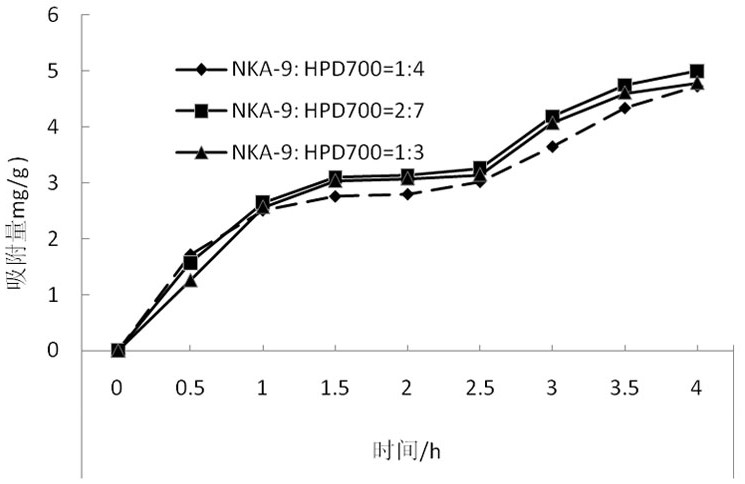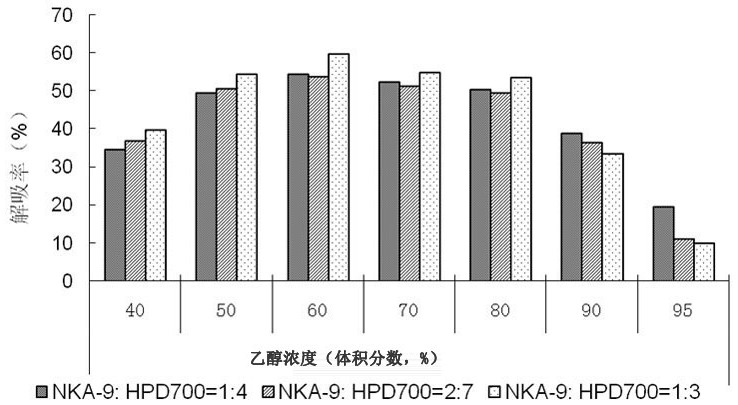A method for separating and purifying plant leaf anthocyanins by using mixed adsorption resin
A technology for separation, purification, and resin adsorption, applied in chemical instruments and methods, organic chemistry, sugar derivatives, etc., can solve the problems that anthocyanins and impurities are difficult to be completely separated, affecting the quantity and purity of anthocyanins, etc. The effect of short static desorption time, prevention of re-adsorption and high stability
- Summary
- Abstract
- Description
- Claims
- Application Information
AI Technical Summary
Problems solved by technology
Method used
Image
Examples
Embodiment 1
[0036] Embodiment 1 preparation of anthocyanin extract
[0037] Take the fresh leaves of Populus chinensis, wash them with distilled water, and dry them. After removing the petiole and veins, cut it into pieces, weigh 3.0g of the sample in a mortar, add 10mL of the extract solution of absolute ethanol: water: HCl = 2:1:1, fully grind until homogenized, transfer to a 50mL test tube, add Dilute the extract to 30mL, shake it well for 1min, and extract it twice with ultrasound, 20min each time. Then bathe in boiling water for 1 hour, take it out and cool it down, dilute it to 50mL with 60% ethanol solution by volume fraction, let it stand still, take the supernatant, filter it with a 0.45μm filter membrane, and obtain the crude extract solution of anthocyanins from poplar leaves.
Embodiment 2
[0038] The optimization of embodiment two macroporous resin models
[0039] According to the preparation method of anthocyanin extract in Example 1, 300 mL of anthocyanin crude extract from poplar leaves were prepared, and refrigerated for future use. Usually, anthocyanin has a maximum absorption peak at 520-560nm in the visible light region. First, use a visible spectrophotometer to scan in the range of 400-700nm to measure the absorption wavelength of anthocyanin. The steps are as follows: take 2mL of the crude extract and dilute to 10mL with 60% ethanol solution by volume fraction, and use the ethanol solution with 60% volume fraction as the control, immediately use a visible spectrophotometer to scan in the range of 400-700nm to determine the concentration of the sample solution. The maximum absorption wavelength of anthocyanins is 531nm.
[0040] Choose non-polar HPD700, HPD100, X-5, weak polarity AB-8, medium polarity XAD-7, XAD-8, HPD500, NKA-9 these 8 kinds of macropo...
Embodiment 3
[0049] Example 3 The preferred mixing ratio of HPD700 and NKA-9
[0050] According to the preparation method of the anthocyanin extract in Example 1, 200 mL of the crude extract of anthocyanin from poplar leaves was prepared, and refrigerated for future use.
[0051] Take the processed macroporous resins NKA-9 and HPD700 respectively, mix them uniformly according to different mass ratios, weigh 1.0g of each mixed resin, put them in a 50mL conical flask with a stopper, add the leaves of Populus fragrans 30mL crude extract of pigment glycosides; shake in a water bath at 25°C for 2h at a speed of 100r / min, and receive the filtrate; put the filtered resin into 20mL of ethanol solution with a volume fraction of 60%, shake in a water bath at 100r / min for 3h at 25°C , suction filtration, and receive the filtrate; respectively measure the absorbance at 531 nm of the anthocyanin crude extract, the filtrate after adsorption and desorption, and calculate the adsorption capacity, adsorpti...
PUM
 Login to View More
Login to View More Abstract
Description
Claims
Application Information
 Login to View More
Login to View More - R&D
- Intellectual Property
- Life Sciences
- Materials
- Tech Scout
- Unparalleled Data Quality
- Higher Quality Content
- 60% Fewer Hallucinations
Browse by: Latest US Patents, China's latest patents, Technical Efficacy Thesaurus, Application Domain, Technology Topic, Popular Technical Reports.
© 2025 PatSnap. All rights reserved.Legal|Privacy policy|Modern Slavery Act Transparency Statement|Sitemap|About US| Contact US: help@patsnap.com



